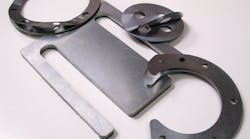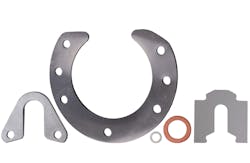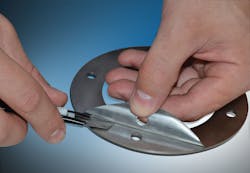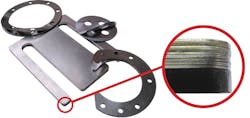Engineers and manufacturers use precision shims to compensate for tolerance mismatches and tolerance buildup between mating components. Using them significantly reduces manufacturing costs by eliminating the need for each component to be precision-machined to have the fit called for in the design. Shims are also commonly used to preserve the faces between mating components, cutting down the amount of machining needed during rebuilds and retrofitting.
Laminated Shims
Laminated shims, also called surface-bonded laminated shims, consist of a stack of peelable metal layers. They are analogous to using a pad of 3M’s Post-It Notes to correct a table with one leg shorter than the other three. You can peel off notes until the stack is just the right height to level the table.
Laminated shims are built up from layers of precision-gauge metal foil. The layers get bonded into a rigid structure that appears and functions as a solid sheet or plate. Adjusting the thickness is as easy as peeling off laminations with a knife, or in the case of some materials, using no tool at all. Once in place, they withstand reasonable handling, including shearing and machining.
Laminated shims, also called surface-bonded laminated shim packs, have each layer bonded to one above and below it over their entire surfaces. Layers are pressed together to cure much like how plywood is manufactured. Unwanted layers must be discarded due to their deformation during peeling.
With laminated shims, there’s no need to stack several individual shims into the proper thickness. Instead, a single shim set can be adjusted to the desired thickness and slipped into position. This eliminates the need to select several loose shims of varying thicknesses that will do the job. Laminated shims also reduce assembly times and the need to catalog and warehouse a slew of different sized shims.
Laminated shims can also be partially solid and partially laminated. This type of shim is either half or three-quarter solid, depending on the ratio of solid section to total thickness. Semi-solid shims add rigidity to assemblies by meeting the performance requirements of thicker, solid shims as they provide a bearing surface on one side. They still let technicians adjust the overall shim thickness by peeling off unwanted layers from the other side.
Edge-bonded shims
Unlike surface-bonded laminated shims, the layers of edge-bonded shims are only bonded to layers above and below them at the edges of that layer’s profile. This makes it much easier to separate layers in the field. Because these shim sets are easy to peel, layers that are not needed can be saved for use in a later application.
Edge-bonded shims have all the performance and cost advantages of solid and loose shims. Another advantage of these shims is that layers of various thicknesses can be combined in a single set, thus giving technicians more flexibility in making adjustments. This is not an option for traditional laminated versions.
Edge-bonded shims also generate additional cost savings because the shim materials are less expensive and removed layers can be reused. And safety is improved because knives aren’t needed to remove the edge-bonded layers. So when adjustment speed, operator safety, and minimizing overall assembly costs are objectives, edge bonded shims provide the best solution.



